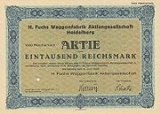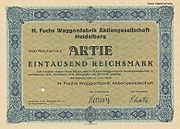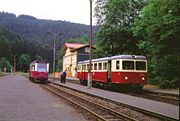
Waggonfabrik Fuchs
Encyclopedia


Heidelberg
-Early history:Between 600,000 and 200,000 years ago, "Heidelberg Man" died at nearby Mauer. His jaw bone was discovered in 1907; with scientific dating, his remains were determined to be the earliest evidence of human life in Europe. In the 5th century BC, a Celtic fortress of refuge and place of...
in the state of Baden-Württemberg
Baden-Württemberg
Baden-Württemberg is one of the 16 states of Germany. Baden-Württemberg is in the southwestern part of the country to the east of the Upper Rhine, and is the third largest in both area and population of Germany's sixteen states, with an area of and 10.7 million inhabitants...
in southwestern Germany
Germany
Germany , officially the Federal Republic of Germany , is a federal parliamentary republic in Europe. The country consists of 16 states while the capital and largest city is Berlin. Germany covers an area of 357,021 km2 and has a largely temperate seasonal climate...
. They built railway wagons and tramways from 1862 to 1957.
The firm was founded in 1844 by Johann Schäfer in Heidelberg and was sold after his death in 1861 to Heinrich Fuchs, who formed the Waggonfabrik Heinrich Fuchs in 1862. Fuchs moved the factory from the district of Weststadt in Heidelberg to the neighbouring district of Rohrbach
Rohrbach
Rohrbach can refer to:* Heidelberg-Rohrbach, a district of the city of Heidelberg in Germany* Rohrbach, Switzerland, in the canton of Bern*municipalities in Germany:**Rohrbach, Bavaria, in the district of Pfaffenhofen, Bavaria...
(completed in 1902).
In addition to railway wagons, in its early days the firm also built bridges and other facilities for the railways. Major customers for its wagons and coaches in the early years were the Baden State Railways.
From about 1901 the production of tramways began. Customers included the Elektrische Straßenbahn Heidelberg–Wiesloch, Heidelberger Straßen- und Bergbahn AG (HSB), Oberrheinische Eisenbahn-Gesellschaft (OEG), Rhein-Haardtbahn (RHB). Even U-Bahn trains were supplied for the Berlin U-Bahn
Berlin U-Bahn
The Berlin is a rapid transit railway in Berlin, the capital city of Germany, and is a major part of the public transport system of that city. Opened in 1902, the serves 173 stations spread across ten lines, with a total track length of , about 80% of which is underground...
and the glass train (Gläserne Zug).
Fuchs survived the two world, but only with heavy losses. Production had to be stopped or almost all its employees had to be made redundant on several occasions. Attempts were made to diversify to other products such as tractors or diggers, but with little success.
The company was taken over in 1930 by the Vereinigung Westdeutscher Waggonfabriken (Westwaggon) and the majority of shares sold in 1940 to the Dillinger Hütte
Dillinger Hütte
Dillinger Hütte is a steel producer in Dillingen, in the German Federal State of Saarland, and has a history stretching back more than three hundred years. The plant was originally founded in 1685, and was Germany's first Aktiengesellschaft, or joint stock company . The first continuous-caster for...
that, due to its location in the Saargebiet, sold its share of Fuchs in 1957 to the International Harvester Company, who switched its production to combine harvesters.
In memory of Heinrich Fuchs, a street in the Heidelberg district of Rohrbach is named Heinrich-Fuchs-Straße.
Today the site of the former Waggonfabrik Fuchs factory is a modern housing estate Quartier am Turm ('tower district') and one of the largest property developments in the city. The architecture of the new district preserved the historical identity of the coach and wagon factory by making use of the existing characteristic structures.
Sources
- Bernhard König: Schienenfahrzeugbau in Heidelberg, auf der Website der Eisenbahnfreunde Heidelberg e.V.. http://www.ef-heidelberg.de
- Bernhard König: Die Waggonfabrik Heinrich Fuchs in Heidelberg, in: BDEF-Jahrbuch 1990, Lübbecke 1990
- Lessing: Triebwagen-Design aus Heidelberg – Die H. Fuchs Waggonfabrik AG, in: Blum (Hrsg.): 'Pioniere aus Technik und Wirtschaft in Heidelberg', Aachen 2000.
- Bauträger E&K Immobilien: Von der Waggonfabrik zu neuem Lebensraum, auf der Website des Bauträgers zum neuen Quartier am Turm. http://www.ek-immobilien.de

